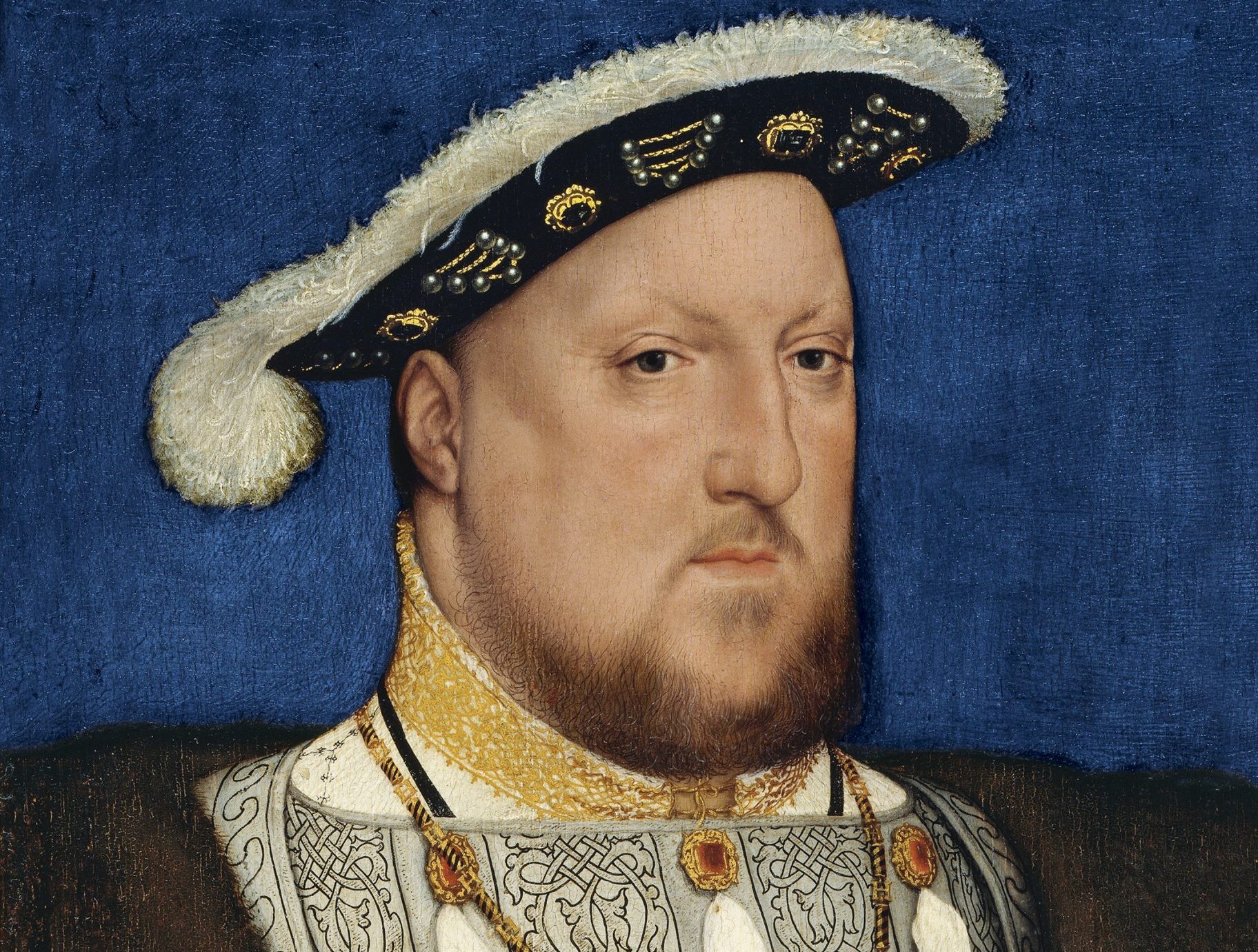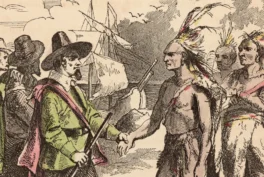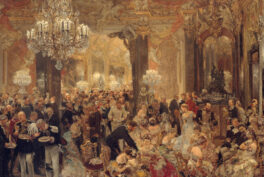Summary
- Henry VIII
- Elizabeth I
- Louis XIV
- Marie Antoinette
- Queen Victoria
Where It Began: Henry VIII
During the 16th century, the Tudors were some of the first monarchs to realize the power of the image. However, that is not to say that they created portraiture. That credit lies with the Egyptians’ stylized, profile depictions, which were continued by the ancient Greeks and Romans. But the British do get credit for revolutionizing the use of portraits. History’s favorite queen-slayer, Henry VIII, is credited as being one of the first monarchs to begin this process. He used his likenesses to cherry-pick wives and spread his power all across Europe during the 16th century.
Henry’s reign was very tumultuous within England; from declaring himself head of the English Church, bringing about the Reformation, marrying six times, beheading two wives, winning several battles, and eventually bankrupting his country, loyalties to the king were often questionable. To squelch any debate, portraits of Henry VIII were adopted as symbols of allegiance – if you could afford one. It is because of this that so many paintings of him survive.
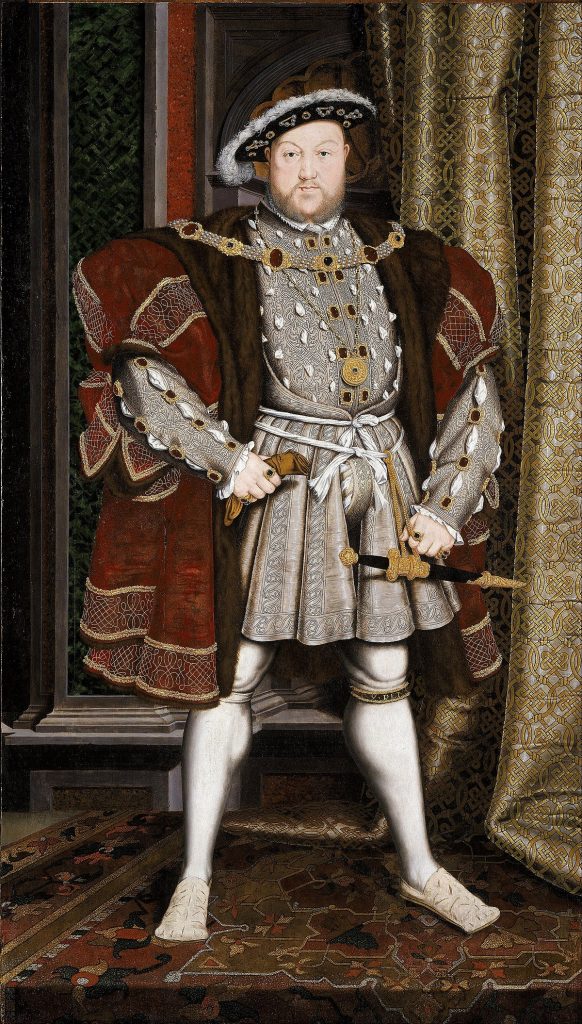
Royal Portraits: Unknown artist after Hans Holbein the Younger, Portrait of Henry VIII, c.1537-1562, Walker Art Gallery, Liverpool, UK.
This particular portrait is based on Hans Holbein the Younger‘s mural of Henry VIII and his family which was housed in Whitehall Palace before it burned down in 1698. While he does not wear a crown nor hold an orb or scepter, his authoritative pose with feet set wide highlights his sovereignty. When the mural was created, Henry was 46. Here, he is shown as being youthful, healthy, and dignified, all qualities wanted in a monarch. He gazes directly at the viewer, his left hand clutching his dagger as if he is ready for action at any moment.
To further emphasize his position, Henry is dressed in elegant jewels and fabrics. It is also important to note the rich fabric hanging behind him. During Henry’s reign, the cloth of honor became an important element of the monarch’s accouterments. Cloths of honor often reference religious themes but due to the Tudors, became known as symbols of royal authority and a further indication of their high status.
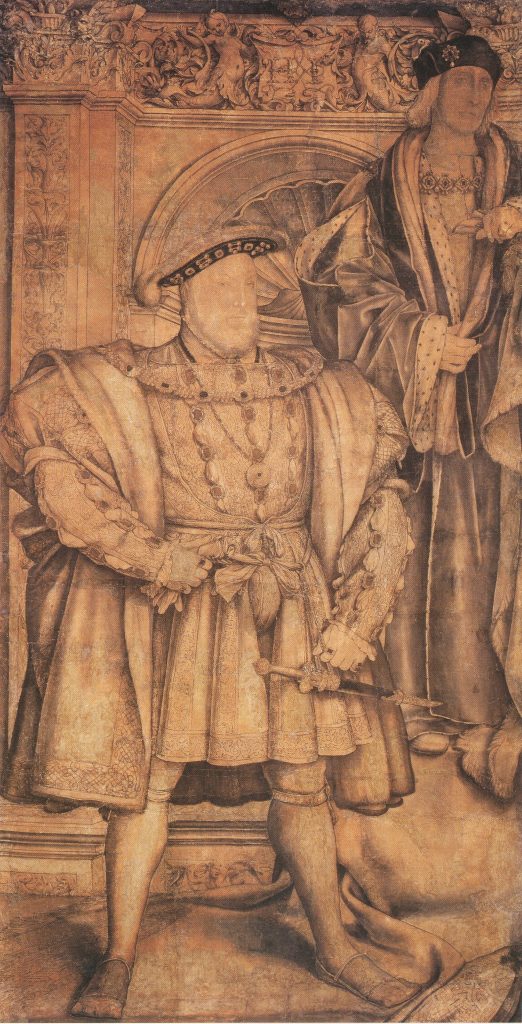
Royal Portraits: Hans Holbein the Younger, King Henry VIII; King Henry VII, c. 1536-1537, National Portrait Gallery, London, UK.
Henry sat for very few of his portraits, thus many were copied from templates. However, Hans Holbein the Younger was able to capture a powerful vision of him in his portraits and studies, such as the one above. This study was done in preparation for the Whitehall mural which unfortunately doesn’t exist anymore. When comparing the aforementioned portrait with Holbein’s study, we see direct correlations between the monarch’s dress, stance, and even setting. The original mural was the first full-length royal portrait created in England. Henry actually commissioned it to commemorate the strength of the Tudor dynasty. It was so majestic it is rumored to have awed those lucky enough to lay eyes on it. Even today, it serves as an archetype for images and portrayals of Henry VIII!
Keeping Up with Tradition: Elizabeth I
Following in her father’s footsteps, Elizabeth I, often called the Virgin Queen, has several royal portraits that stun with their splendor! As a female monarch in an age dominated by men with a convoluted lineage, Elizabeth worked tirelessly to craft an image that matched her male predecessors and counterparts.
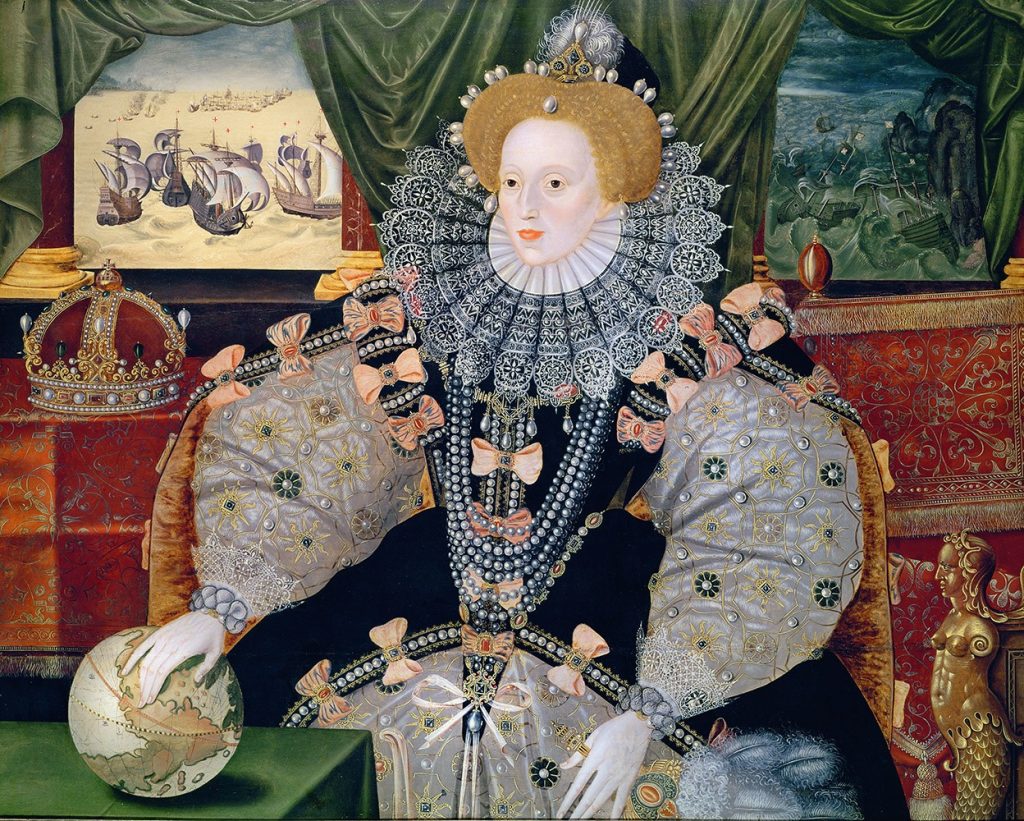
Royal Portraits: The Armada Portrait, c. 1588, The Woburn Abbey Collection, Woburn, Bedfordshire, UK.
The Armada Portrait is one of the most widely known portraits of Elizabeth. In fact, there are three different versions of this portrait! The Woburn Abbey version, pictured above, is the truest to the original. All three were created to commemorate her victory over the Spanish Armada. In the panels behind the queen, we see two different scenes chronicling what was perhaps Elizabeth’s greatest victory. On the left, we see the English vessels setting out to drive the Spanish away. Meanwhile, the panel on the right depicts the shipwreck of the Spanish ships as they sail through rough seas around Ireland and Scotland.
As if to top her father, the queen is dressed to the nines, surrounded by a literal treasure trove of luxurious items – not to mention symbols. Elizabeth frequently used symbolism to craft the ideal image of a beautiful, yet strong, able-bodied queen. She is placed directly in the center of the composition, immediately drawing all your attention to the queen. Her porcelain skin, strong chin, and direct gaze reflect her attentive and fearless approach to her duties. The delicate lace ruff around her neck radiates like sun rays or a halo. To contrast the masculinity she channels here, the pink bows adorning her dress add a feminine touch.
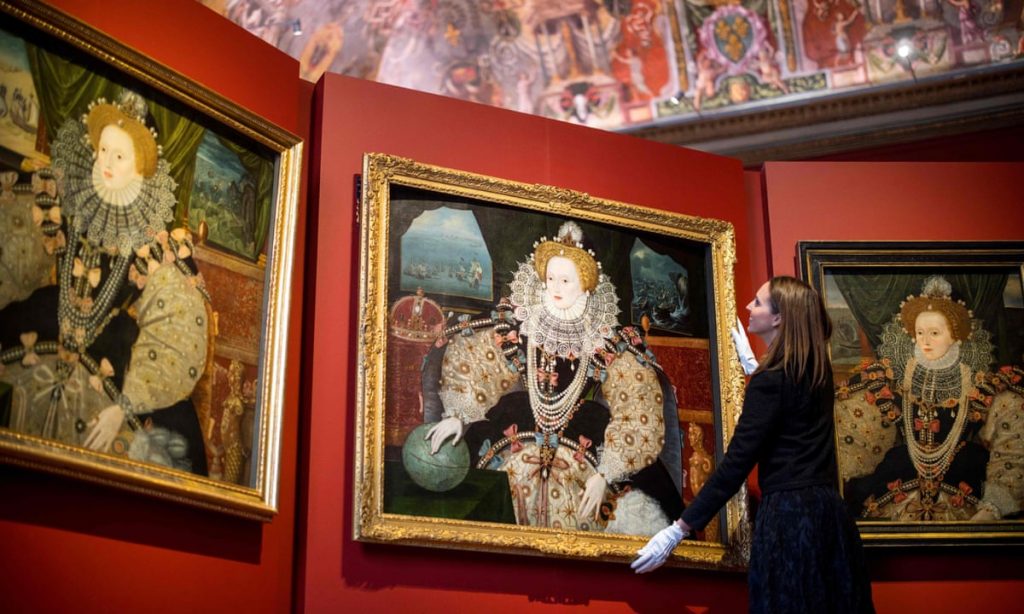
Royal Museums Greenwich curator Allison Goudie adjusts one of the Armada portraits before the opening of the Faces of a Queen exhibition. Photograph: Tolga Akmen/AFP via Getty Images, The Guardian.
Even the color scheme has a meaning. Here, black symbolizes constancy, while white symbolizes chastity. To reinforce her purity, Elizabeth is drenched in pearls. Locating the 800 or more pearls that hang from her neck and adorn her hair and dress would have been no easy, or cheap, task, especially in Elizabethan times. The Queen often went to great lengths to highlight her virginity. She came by the name, the Virgin Queen because she chose never to marry. At that time, taking a king meant he could override your decisions. Needless to say, Elizabeth was not fond of that idea.
But wait, there’s more! Behind the Queen, we again see the cloth of honor, referencing her authority. Just in case you didn’t already know she was a monarch, the arched crown sits to Elizabeth’s right. The crown also symbolizes the Tudors’ claim that they were descended from Brutus of Troy. According to legend, Brutus was descended from the mythical first king of Britain, Aeneas. Under the crown, is a globe. The Queen’s fingers point towards America, suggesting Britain’s quest to expand the empire.
Louis XIV: L’état, C’est Moi!
Like the trade of goods, ideas, including artistic and political ones, were spread wide through commerce and travel. Thus, much like the Tudors, Louis XIV also came to realize the importance of visual and verbal propaganda. With France’s reputable taste for all things expensive, shiny, and beautiful, it comes as no surprise that the infamous Sun King, the brainchild behind Versailles, has at least one portrait that rivals that of the Tudors.
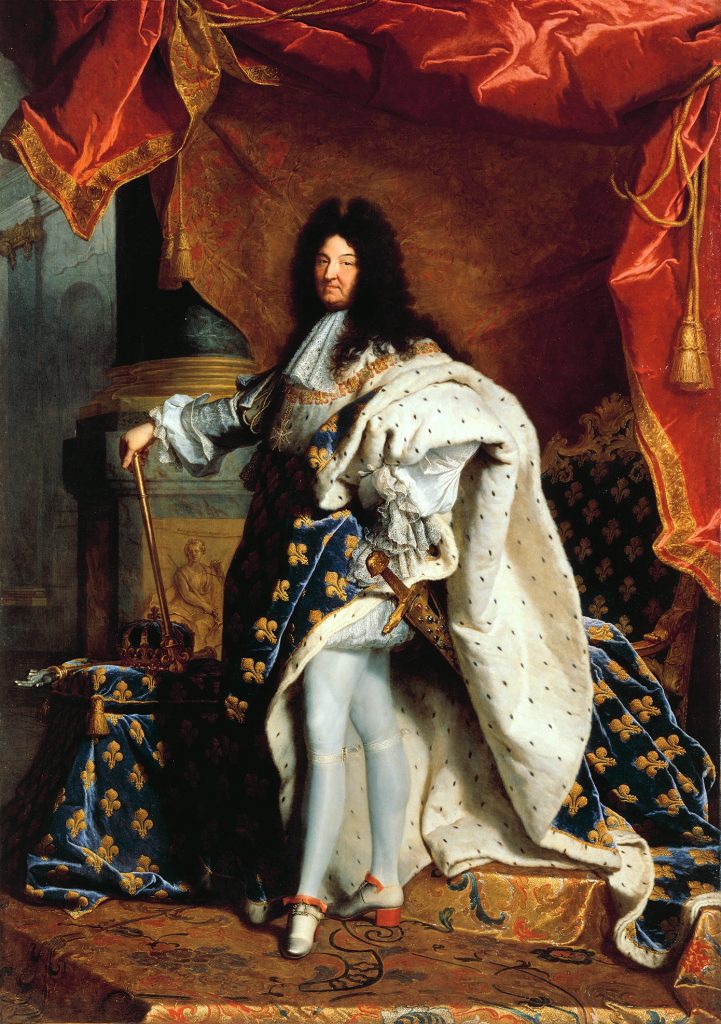
Royal Portraits: Hyacinthe Rigaud, Louis XIV, 1701, Musée du Louvre, Paris, France.
By the mid-17th century, France had overshadowed England as Europe’s largest and most powerful entity. Louis XIV reigned as the absolute monarch, with very few, if any, limitations. To further inflate his power, he became known as “le Roi Soleil”, or “the Sun King.” This name alluded to his divine lineage to the Greek god, Apollo and simultaneously, but not so subtly, declared him the center of the universe. Hence, it truly comes as no surprise that every detail in his portrait is intended to remind viewers of his supremacy as a monarch.
We again see the King placed directly in the center, drawing all eyes to him with his authoritative pose. While his body is angled, his head is turned to meet the viewer with the directness and confidence expected of a king. Each shimmering, luxurious textile is included to create an opulent environment appropriate only for someone of Louis’s status. He is dressed in his coronation robes; the black and white ermine as well as the field of rich blue embellished with gold fleur-de-lis, symbolize the French monarchy. Hanging from Louis’s hip is a bejeweled royal sword, highlighting his military prowess. Just in case you forgot he was king, his crown rests in the shadows just to his right.
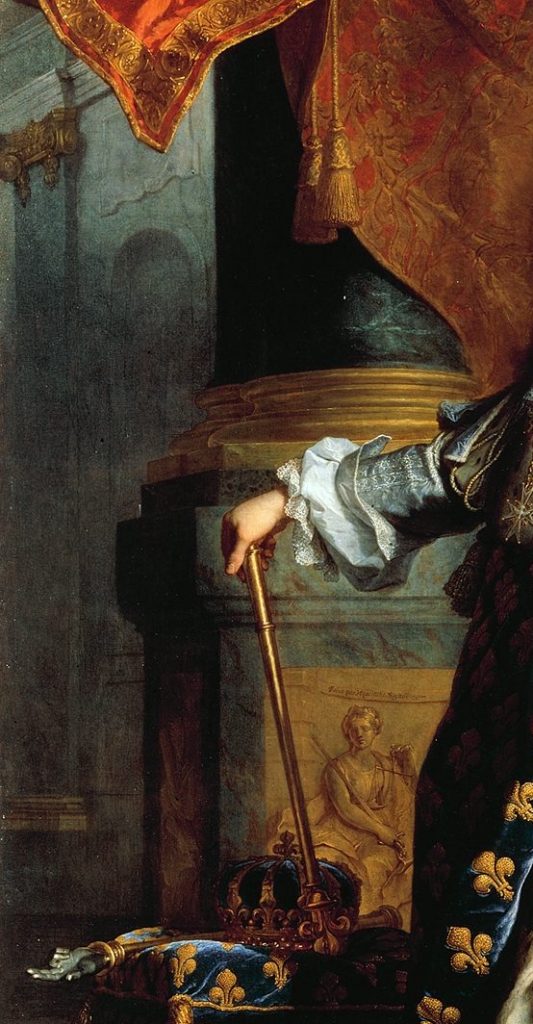
Royal Portraits: Hyacinthe Rigaud, Louis XIV, 1701, Musée du Louvre, Paris, France. Detail.
Behind the lavish cloth of honor, we see a marble column that symbolizes his strength while also recalling elements of the classical era. Much like the busts of ancient Greek and Roman rulers, Louis’s appearance is quite idealized. At the time this portrait was made, the king was 63. Naturally, you would expect him to have less hair, scrawnier legs, and perhaps, a bit less height. Naturally, Louis favored an idealized portrayal of himself to share with the court and his subjects. Thus, Hyacinthe Rigaud met the King’s requirements.
Although Louis was quite short, Rigaud’s life-size portrait creates an illusion of height that allows Louis to look down upon his viewers. His legs are positioned in a way that allows viewers to see the lean muscles he developed as a ballet dancer but might not have had at 63. Likewise, his long, luscious wig alludes to a youthful, resilient king. The only features that portray his otherwise youthful appearance are his sagging jowls and double chin.
Marie Antoinette: Let Them Eat Cake
Like their predecessors, Louis XVI and Marie Antoinette were known for their very opulent lifestyles. It just so happens that this lifestyle eventually bankrupted France and drove the country into utter anarchy AKA The French Revolution. In an attempt to try to save their images, and their names, these ill-fated monarchs have a few politically motivated, yet striking portraits.
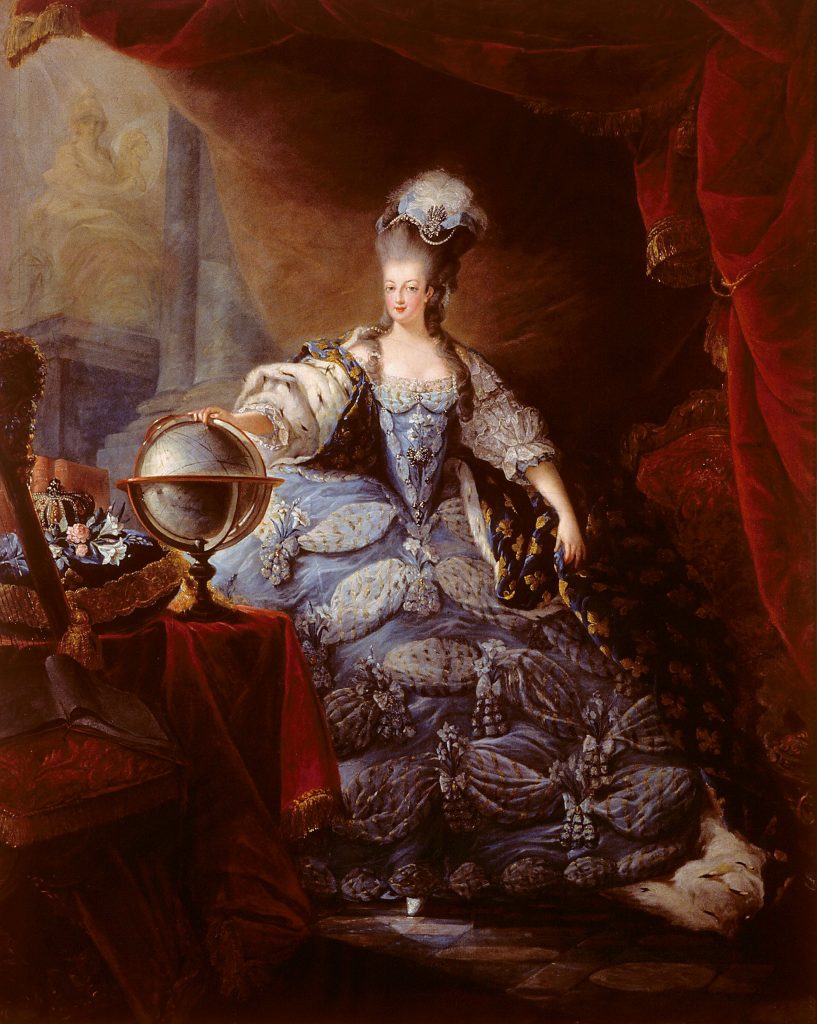
This particular portrait by Gautier-Dagoty was commissioned by the Queen herself. He had quite the task set before him, seeing as he was creating the first official portrait of the new Queen in a full-court dress. And dressed she is! At this time, French queens were expected to be on top of the newest fashion trends. Contrary to what you might think, Antoinette loved this job. Her dress appears to float around her as if she were seated on a blue cloud. Her bodice and wig are adorned with jewels. If we look closely, they appear to be pearls. Those pearls, the lilies on the table to her right, and at the very tip of her bodice symbolize her purity.
Appearing youthful but mature, Antoinette takes center stage in this royal portrait. In the background, we see the typical symbols of royal authority, the marble column, suggesting the monarch’s strength, and the cloth of honor draped all around her. We can even see half of a crown resting next to the lilies. It likely comes as no surprise that she is surrounded by glistening fabrics, signifying her wealth and status. To identify her as a French monarch, the artist has dressed her in a rich blue robe with ermine trim, adorned with France’s fleur-de-lis. Additionally, her right hand sits on top of a globe, suggesting her newfound country’s desire to expand.
A Queen’s Appeal to Humanity

Royal Portraits: Elisabeth Louise Vigée Le Brun, Marie Antoinette and Her Children, 1787, Palace of Versailles, Versailles, France.
After suffering much criticism from her people for her frivolous spending and inconsiderate nature, the court felt it might be best to try to save face. Thus, Elisabeth Vigée Le Brun, the first woman to become a painter to the King, created this maternal portrait. Here, we see Antoinette in a more understated setting, spending time with her children. This theme was chosen to create a dignified, yet loving, maternal image of the queen.
While she is spending time with her children, dressed in a beautiful red velvet gown, her gaze is not directed straight ahead. Instead, she gazes a little off to her right with a rather sullen expression. This is believed to be due to the empty bassinet which the little boy gestures towards. That imagery reflects the Dauphin’s death, which greatly troubled Antoinette as we see in this royal portrait. By constructing a tender, maternal image of the queen, the court hoped she would become more relatable to her people. However, as history would have it, it seems this portrait was not wholly convincing.
The Long Reign: Queen Victoria
19th century Britain once again found itself with a young, female queen who was treading a similar path to that of Elizabeth I. In another male-dominated era, Victoria struggled to gain respect from her male counterparts. When it came to marriage, she, like Elizabeth, had reservations about how the alliance would affect her influence over her own job. She also worried that having children would adversely affect her abilities. Despite her worries, she became one of Britain’s most revered monarchs.
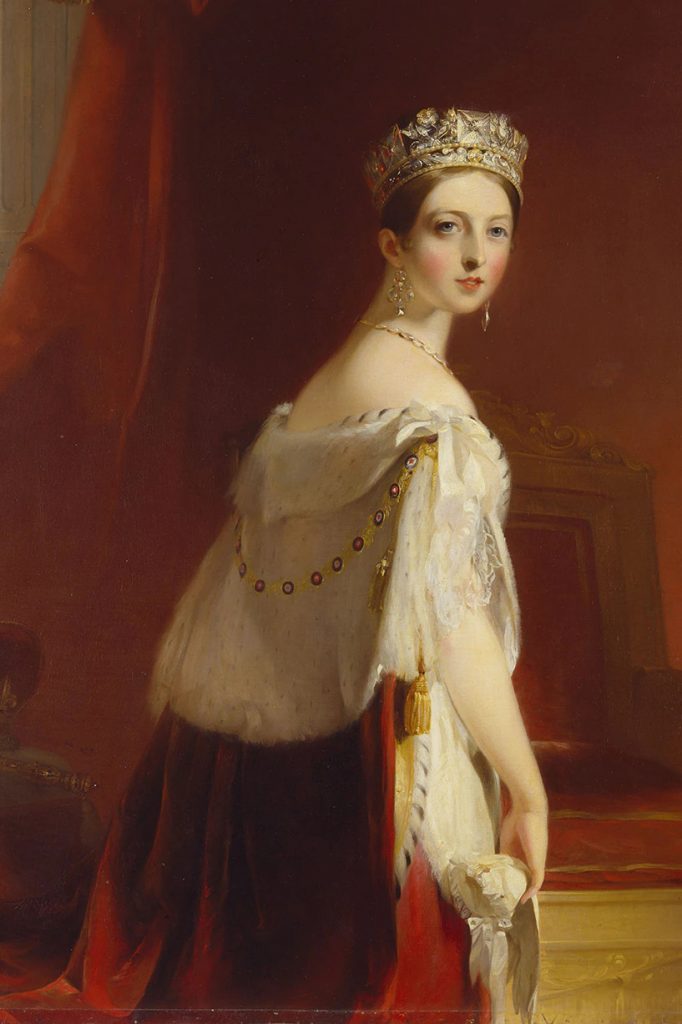
Upon a return trip to London, American artist, Thomas Sully received a request from the Society of the Sons of St. George to paint a full-length portrait of Queen Victoria. For Sully, it turned into quite a whirlwind of sittings with the Queen, dinner parties with lords and ladies, and frequent visits to the theater. During that time Sully created meticulous studies that he would later use to craft one of the most acclaimed images of Victoria.
Many artists struggled to create a likeness of Queen Victoria that was youthful but not naive, solemn but not severe. Sully succeeded. Here, in quite a different portrait than we’ve seen before, the Queen appears caught off guard as she glances over her shoulder toward the viewer. As opposed to the masculinity of Elizabeth I, this approach allowed Sully to show her in an authoritative, yet feminine light. The angle of Victoria’s body allowed the artist to highlight the line of her long neck and bareback as well as her delicate face. In turn, creating the perfect amount of seriousness and beauty.
With Sully’s portrait, the heavy symbolism of times past was replaced with much simpler imagery. Queen Victoria is surrounded again by luxurious fabrics and dressed in a white gown and her coronation robes topped off with a sparkling tiara. The arched crown symbolizing her authority is present behind her in the shadows. Those shadows create a sense of drama as young Victoria approaches her throne, perfectly symbolizing this pivotal moment in her life.
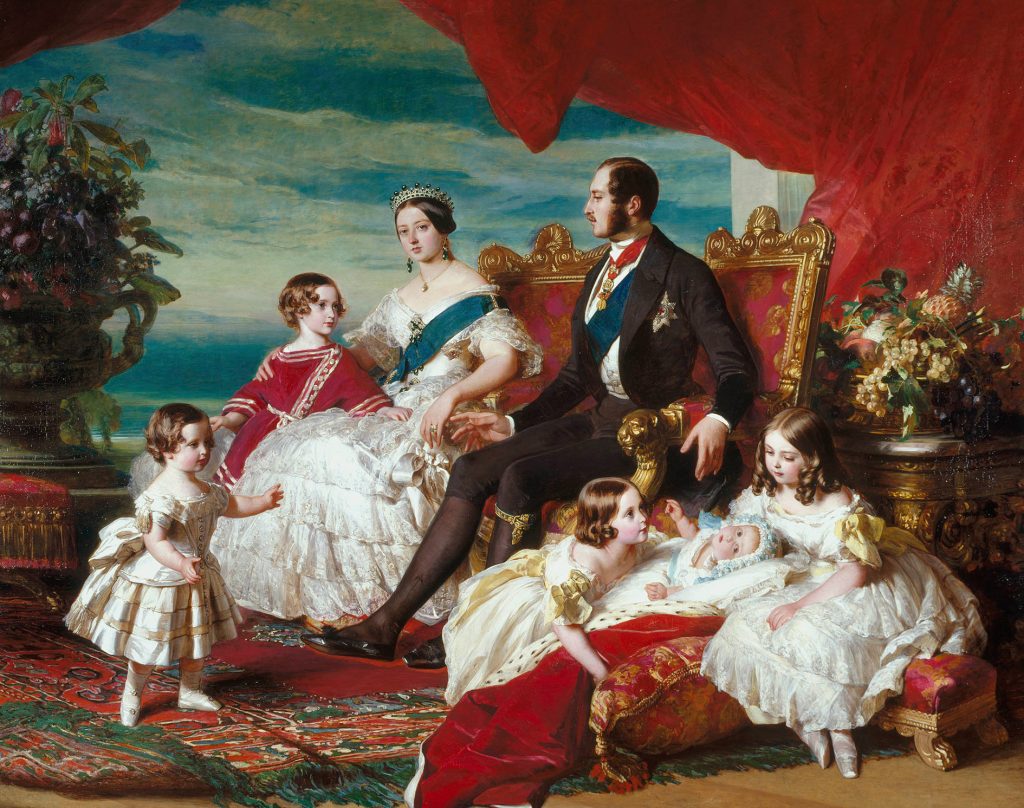
Royal Portraits: Franz Xaver Winterhalter, The Royal Family, 1846, Buckingham Palace, London, UK.
After becoming a mother, Queen Victoria’s subjects felt disconnected and desired a sneak peek at life in the palace. Here, Winterhalter creates a scene of domestic peace, including the obvious references to wealth and power in Victoria and Albert’s extravagant clothing and jewels as well as the rich textiles surrounding them. Above them all, is a cloth of honor, highlighting their authority.
The artist hints at a bit of incongruity by showing Victoria and Albert in clothing less suitable for family bonding time and more for a dinner party. In fact, Victoria wears the emerald and diamond diadem Albert designed and had made for her as a gift. In the end, we have an image of the royal family, showing them as both a family and a monarchy. By including the children, Winterhalter also portrays the strong continuation of the dynasty. This was precisely the type of image the family hoped to spread widely, providing the people with the connection they desired.
To Sum It All Up…
Now we know just how carefully crafted these royal portraits are. While it often doesn’t appear so, each royal portrait is not simply a means of showing off your wealth – unless you happen to be French. Each royal portrait is a unique testament to a monarch’s power, youth, strength, and ultimately, their name. Several of these portraits were copied in engravings and more easily spread throughout the nation. Some were even printed on coins, giving the people an accessible likeness of their monarch. In many cases, these images aided history’s monarchs in becoming the unforgettable figures still studied today.
